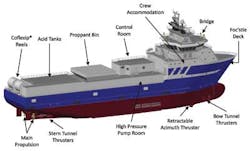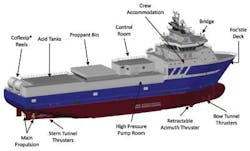Next-generation stimulation vessels meet today's performance demands
A.N. Martin
S. Austin
A. Glennie
J. Martinez
S. Bradford
Baker Hughes
Today's preferred method of offshore vessel-based stimulation involves multi-zone treatments of horizontal wells – a technology first perfected in the North Sea. A vessel in today's market must perform large-volume, low-rate matrix acid treatments, high-rate Paccaloni-style matrix acid treatments, acid fracturing, and high-concentration proppant fracturing. Furthermore, a vessel must be able to perform treatments at a rate of at least 60 bbl/min. There is also a small but increasing demand for treatments in high-pressure/high-temperature (HP/HT) formations, requiring the entire vessel to be rated to 15,000 psi maximum working pressure. There has been a significant increase in demand for automation (to reduce both the number of offshore personnel and the incidence of human errors during treatments), real-time remote treatment data transmission (again, reducing the need for offshore personnel), increased storage capacity for all materials (to increase the number of stages treated between loadouts, rather than to increase the size of the stages themselves), increased requirements for environmental compliance, increased equipment reliability and redundancy, increasing demands for dynamic positioning and station-keeping capabilities, improved crew welfare, and stricter requirement for (and enforcement of) QA/QC and competence systems.
Stimulation plant
The North Sea is the only area in the oil and gas industry that requires stimulation vessels to have both very large acid storage capacity and very large proppant storage capacity (although this is becoming increasingly important in both Brazilian and Angolan waters).
The primary North Sea stimulation treatment is a multi-zone horizontal completion. Most vessel-based operations are performed with a rig on site. If the rig is a jackup or a semisubmersible, then the rig time contributes the largest percentage of overall costs, so it makes economic sense to limit the waiting time spent on stimulation vessels returning to port for restocking. This has led to the use of ever-larger hulls. The first dedicated vessel mobilized to the North Sea was 249 ft (76 m) long and has a 3,424 metric tons (3,774 tons) dwt. The most recent vessel is 311 ft (95 m) long and has a 5,150 metric ton (5,677 ton) dwt – this increase in deadweight tonnage provides for a corresponding increase in both marine and stimulation capabilities.
Reducing non-productive time
Reducing or eliminating non-productive time (NPT) due to equipment failures is key to keeping within budget for offshore stimulation operations. Important elements have to be considered for low and ever-decreasing NPT. First is equipment design. The reliability of modern equipment far exceeds that of the previous generation, due to improved equipment design and materials, combined with 30 years of operational experience in one of the oil industry's harshest environments.
Second is a formal and rigidly enforced preventative maintenance (PM). The implementation and enforcement of QA systems is one significant change the industry has experienced over the last 30 years and a rigorous PM system is a major part of this process.
Another factor is equipment redundancy. The latest generation of stimulation vessels incorporates full redundancy in all treatment-critical systems. The new generation vessels' mixing systems, valves, feed pumps and meters have at least 100% redundancy. While most vessels feature significant critical equipment redundancy, for the older generation of vessels this was largely fitted retroactively, rather than being designed into the systems from the outset.
Fourth is station-keeping. The ability to stay on station alongside a rig or platform is a key part of reducing NPT.
Blending and proportioning
The latest generation vessels incorporate systems that allow acid, water, and additives to be blended without going through an open tub. These closed systems minimize spills and eliminate potentially hazardous fumes. Treatments using the closed automated systems are possible over a wider range of rates than the 1980s generation of vessels, typically from 0.25 to 80 bbl/min. Multiple modes of acid blending are usually available, allowing batch mixing of smaller-volume acid treatments and of specialized stages during larger treatments. Acid strength or percentage usually is confirmed by monitoring with a Coriolis-effect density meter.
New vessels incorporate computer-controlled proppant proportioning systems for accurate and reliable delivery of the proppant. Older vessels have manual or semi-automatic systems (although these have generally been upgraded to fully automatic over the years) fitted to them. The blender tubs are often directly under the proppant silos, to simplify the proppant and eliminate belt-delivery systems used by some of the previous vessels. The proppant bin is usually divided into compartments, with smaller compartments for specialty proppants. The slide gates positioned and the bottom of the proppant silos open and close from the control room, and the entire proppant delivery schedule can be preprogrammed.
Proppant can be transferred from the below-deck proppant storage area to the above-deck proppant bin using pneumatic conveying. It is also usually possible to return proppant from the above-deck bin to the below-deck tanks.
Evolutionary control and monitoring systems
Custom-embedded microprocessors control all chemical and proppant additives. The entire stimulation plant is controlled from inside the control room. Touch-sensitive control software allows the operator to switch valves, adjust loadings, and control the high-pressure pumps. Wireless touch-sensitive panels are used. These allow operators and technicians to walk the vessel while operating the equipment, usually during maintenance or commissioning. The heart of the monitoring system is an embedded data acquisition system that gathers and transmits data to the analysis software.
Typically, the latest generation of North Sea stimulation plant has a fully enclosed deckhouse and protected external accessways.
HSE plans ensure that all related issues are addressed during the project cycle. This includes a concept risk assessment (CRA), a build and installation risk assessment (BIRA), and a project risk assessment (PRA). Over the past 30 years, service companies have gained knowledge and experience in stimulation vessel operation. This expertise has been used to develop analysis techniques such as NORSOK S-002 and S-005, from which the HSE plans for the new vessels are derived.
Seawater as a base fluid
The North Sea is the only major area of offshore stimulation activity that regularly uses sea water to mix stimulation fluids. Not having to store fresh water on the vessel means that additional volumes of acid and/or proppant can be stored instead.
The major difficulty using seawater comes during pumping crosslinked fluids for proppant fracturing, especially high-pH systems such as borates. These systems are fairly easy to use with seawater up to around 185°F (82°C), provided specialized buffering and/or sequestrating systems are used. Between approximately 185°F and 220°F (104.4°C) they become increasingly difficult to buffer and to maintain a pH of above 9.2 at bottomhole temperature (required for the borate ions to crosslink the guar-based polymer). Above around 220°F, these systems require enormous volumes of buffering additives to maintain stability and in addition risk the formation of precipitates.
These problems are primarily caused by divalent and trivalent metallic ions such as calcium, magnesium and iron, as well as a few other more complex species. The traditional approaches of simply adding more buffers or using increasingly sophisticated sequestration systems are becoming less and less attractive. Cost, logistics and environmental compliance all affect the choice of whether to use fresh water.
High-pressure surface lines
A safer, more compact alternative wing and thread-style hammer unions has been implemented for the new generation of vessels. The rigging-up and -down of high pressure lines is one of the most hazardous operations whether offshore or on land. The North Sea leads the industry in replacing these, and the new generation vessels are the first to eliminate both 3-in. and 4-in. high-pressure hammer unions. The high-pressure "hammerless" connections are durable, leak-resistant, and have superior vibration resistance. They are also faster to disassemble. This pipework features universal connections, eliminating male and female ends and preventing unbalanced flow wear.
The liquid additive system is one of the main areas to benefit from increased automation, redundancy and reliability. Stainless steel piping delivers additives to the process streams. Three-way ball valves direct the additives to the injection points. Additives are stored in stainless steel tanks. The loadings for the additives are programmed into the treatment control systems prior to the job. During the treatment, Coriolis-effect flow meters are monitored by the control systems. Continuous adjustments to the speed of the chemical pumps provides accurate loading.
Marine systems
Increasingly tight regulations in the North Sea mean that the latest-generation stimulation vessels need the ABS Notation for Protected Oil Tank (POT) or equivalent, which insures compliance with MEPC/141 (54), Regulation 12A (the so-called "clean class" requirement). The most important consequence of this classification is that there is no cargo oil, ship's fuel, or ship's lubricating oil tanks against the vessel's hull. This way superficial damage to the vessel will not risk oil pollution.
Another requirement is that the new vessels be fitted with a ballast water treatment plant according to MEPC188 (60). This prevents the spread of aquatic invasive species.
Most stimulation vessels are based on hulls designed to be platform supply vessels (PSVs). The last 30 years has seen innovations to PSV hull design to maximize hydrodynamic efficiency. Modifications from prior hull designs are based on analysis and testing to achieve the most effective hull form possible, while maintaining the capacity for high deadweight that is required for effective PSV (and well stimulation) operations.
The propulsion system design criteria are reliability, supportability/maintainability, low environmental impact, and accurate DP capability.
The propulsion system comprises four main elements:
Control systems.These are comprised of an integrated bridge, alarm and monitoring systems, power management, thruster controls, dynamic positioning, position reference systems and remote monitoring.
Diesel generator sets.The modern generator set is typically IMO II or EPA Tier 2 compliant, as required, and comprises the engine and an independent, two-bearing, water/air-cooled, medium voltage (MV) alternator, mounted on a common fabricated frame. The generator sets are isolated from the vessel structure using anti-vibration mounts. MV is usually used for the power electric systems. Copper conductors and windings are typically used for all applications.
Drives. The latest North Sea stimulation vessel incorporates fixed pitch propellers (FPP). Variable-frequency MV drives and switchgear are used to control all thrusters, so that thrust and direction of thrust are controlled by varying the speed of the propeller, not by varying the pitch of its blades. The drives are water-cooled, active rectifier type, without transformers.
Thrusters. The latest generation of North Sea stimulation vessels typically combine main propulsion propellers (standard or azipod), stern tunnel thrusters, bow tunnel thrusters, and drop-down thrusters. Key in the vessel's ability to maintain station under harsh conditions, the number and type of thrusters is as important as the amount of thrust each produces.
Typically, the vessels are classed to the ABS DP-2 SKP (Station-Keeping Performance) standard or equivalent, with the environmental parameters equivalent to DNV ERN 99.99.99. This ensures effective DP performance in the North Sea in the "as low as practically possible" risk category.
The next-generation vessel design integrates environmental protections from the outset. The vessels are typically zero-discharge with large holding tanks for gray water, wash water, and Modern hulls are designed to significantly reduce drag. The marine and stimulation systems of the new vessels have fuel efficiency and lower emissions designed in, providing both economic and environmental benefits.•
Acknowledgments
The authors thank the management of Baker Hughes for permission to publish this technical paper. The technical details and illustrations of the high-pressure lines were included with the kind permission of Kevin DeLaat at Weir SPM. The authors are grateful for the help and advice from Gary Rook of Edison Chouest. Many thanks are also due to Blake Burnette for his valuable input to completing the paper as well as to Stephanie Weiss for her assistance with the preparation of the final manuscript. The foregoing is excerpted from a Baker Hughes presentation at the SPE Annual Technical Conference and Exhibition.


